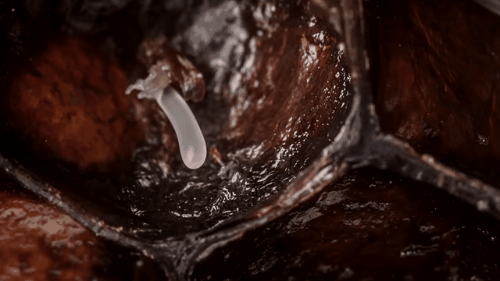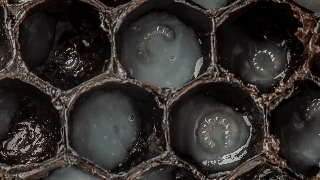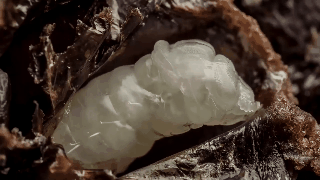The early days of bees through the true beam of images
It is not wrong to say that where there are bees, there is richness and freshness. Although bees are extremely annoying at times, without bees, 30% of the crops will not "sprinkle silk", or 90% of the plants that need cross pollination will not be able to fulfill their obligations.
But have you ever wondered about bee formation and development? Photographer Anand Varma will give you the answer when you follow and record this process meticulously.
According to Anand Varma, in 21 days, larvae hatched from bee eggs, then developed into pupae and became young bees.

Bee eggs are shaped like a maggots.
Bee eggs are shaped like a maggots, milky colors, big and small heads. The small head is stuck to the bottom of the honeycomb, which later develops the belly component of the bee.

On eggshell with fluid, milky white eggs are slightly clear.
On eggshell with fluid, milky white eggs are slightly clear. After 3 days, the eggs will hatch into larvae. Before the eggs hatch, worker bees to put their heads into the nest hole to produce a milky fluid to make the eggs easier to hatch.

After 3 days, the eggs will hatch into larvae.
During the larval period, they were fertilized by bees and craftsmen 1,000 - 1,300 times / day so the larvae grew very quickly.
Larvae molt 5 times and do not excrete but accumulate in the middle intestine. Before emulsifying, this residue is discharged to the bottom of the nest hole. After the bee hatches, other worker bees will come and clean up "this pile of waste".

Larvae molt 5 times and do not excrete but accumulate in the middle intestine.
Bee larvae belong to the naked nymphs. First pupae are white, then turn into milky white and pale pink. This stage also marks the formation of the bee's legs, wings and internal organs.

Bee larvae belong to the naked nymphs.
After a few days, the bee's eyes changed color: the first day was milk, the second day was pink, the third day was pink, the fourth day was dark pink, the fifth day was dark brown.

After a few days, the bee's eyes changed color.
Young bees after growing wings will bite the lid of the nest. The cocoon will stick on the wall of the nest, so each generation of young bees will make the hole's volume narrow and black.

Young bees after growing wings will bite the lid of the nest.
After "finishing", bees can find their own prey and start their own independent lives.
- Close-up of the first 21 days of bee life
- Unseen eyes, unbelievable but true images
- The secret of bees
- The species of bees disappears, the species is extinct
- How to recognize killer bumblebees
- The researchers identified 15 new bees and bees
- Bees once fell into great extinction
- Honey bees can enjoy pictures
- Find out the 'secret' to make honey bees into queen bees
- Killer bees from Africa
- The United Nations calls on the world to save bees
- Unbelievable but true images in the animal world
 Why do potatoes have eyes?
Why do potatoes have eyes? 'Tragedy' the world's largest carnivorous life: Death becomes ... public toilet
'Tragedy' the world's largest carnivorous life: Death becomes ... public toilet Tomatoes were once considered 'poisonous' for 200 years
Tomatoes were once considered 'poisonous' for 200 years Detecting microscopic parasites on human face
Detecting microscopic parasites on human face